‘Too old at thirty-three’: the log of William Henry O’Brien, 1908–10
Published in 20th-century / Contemporary History, Features, Issue 5 (Sep/Oct 2005), Volume 13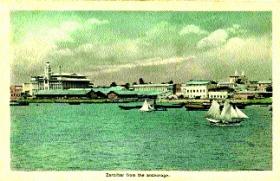
Zanzibar—Pandora’s tours of duty were to be spent in almost continuous passage up and down the east coast of Africa as far north as Zanzibar.
On 25 September, after a short spell in the Royal Naval barracks in Devonport, he travelled to Portsmouth and ‘joined Pandora . . . found her in a very dirty condition and badly in need of a scrub out’. HMS Pandora, built in 1900, was the last of the Pelorus class of eleven ships rated as third-class cruisers. Displacing 2,200 tons, she was 328ft long with a breadth of 37ft 4in. She carried a complement of 217, including thirteen officers, 21 marines and one boy, and was now under the command of Capt. Davidson. Pandora was to have a relatively short service life, being sold for scrap in July 1913, rendered obsolete by major advances in naval technology.
A world of traditional courtesies and protocols
William O’Brien had been promoted to petty officer second class on 3 May the previous year (1907). Now 31 years of age, he had already recorded in his log a three-year tour of duty in HMS Phoebe on the Australia station from 1901 to 1904. Written in a hard-backed copybook to which he had stitched a protective canvas cover, it is self-evidently a seaman’s log at a time when the navy was still acting as the visible British presence throughout the extended empire, fulfilling a wide range of duties from rescuing missionaries from unsympathetic ‘natives’ to exchanging elaborate 21-gun courtesies with minor colonial administrators, British and foreign, as well as with warships of many nations in port and on the high seas. It was a world of traditional courtesies and protocols that, within a few short years, the outbreak of the 1914–18 war would bring to an abrupt end.
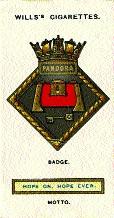
The badge of the Pandora
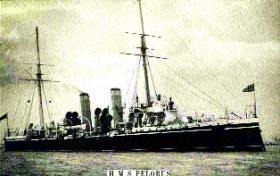
sister-ship Pelorus, which Pandora relieved at Jamestown, St Helena, 8 November 1908.
But how did he, as an Irishman, see himself as a servant of empire? The log is silent on such matters. His background was Protestant and—though his grandfather had apparently been disinherited by the Inchiquin O’Brien connection for marrying a Catholic—of the landed class. This grand-father, John O’Brien of County Clare, had himself served in the Royal Navy with the rank of captain. William’s one and only clear reference to the Irish in the British service is in the entry for 3 May 1910, when Pandora was in Zanzibar:
‘Teams representing England & Ireland played a F.B. [football] match at the Admiralty ground. After a spirited game the English team won by 2 goals to nil. After the match both teams retired to the canteen for refreshment.’
There is little enough to be made of that, except that there must have been at least eleven Irish among the ship’s complement. It might have been interesting, nevertheless, to have been a fly—or more likely a mosquito—on that canteen wall.
The importance of coal
If, as Napoleon is alleged to have asserted, an army marches on its stomach, the navies of the early twentieth century were equally dependent upon vast and regular supplies of coal. The business of coaling a 2,200-ton cruiser such as Pandora was always dirty, at times difficult and not infrequently hazardous. On 3 October 1902 O’Brien, on Phoebe, had arrived at Nouméa, capital of the French Pacific colony of New Caledonia. The following day his log recorded:
‘Coaled from S.S. Moresby, finishing at midnight 300 tons. While coaling I had the misfortune to meet with an accident, sustaining a compound fracture of the skull, which necessitated my being sent to the French Military Hospital where I was treated very kindly & made a rapid recovery.’
His ship sailed without him, but by 20 October was back in Nouméa, taking on another 120 tons of coal, by which time ‘having nearly recovered from the effects of my accident I was discharged from Hospital to the Ship & left for Sydney N.S.W. same day’.
In Portsmouth at 9am on 6 October 1908 Pandora was commissioned for service on the Cape station. Before she could sail, however, she had to be scraped and painted white, coaled—450 tons, a task that took from 6am to 4.15pm on the 9th—provisioned and inspected by Capt. Hyde Parker. On the 14th the crew were ‘paid a month’s advance which was very welcome. Most of us being on the rocks’. On the 16th the ship ‘left farewell jetty & proceeded to Spithead, swung for adjustment of compasses, carried out anchor trials and afterwards a repair trial which proved unsuccessful . . .’. Finally, on the 17th, Pandora ‘weighed & proceeded with trials 10.40am. Anchored and discharged dockyard officials, weighed & shaped course for Madeira . . .’
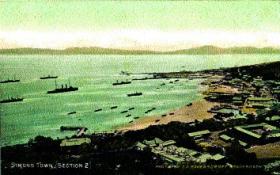
Simon’s Bay, Simonstown, South Africa—home base of the British navy’s Cape squadron
Detailed descriptions of ports of call
Whereas on his first tour of duty O’Brien had largely confined the entries in his log to day-to-day routine on board ship, he was now casting his net more widely, providing detailed descriptions of Pandora’s successive ports of call. While many of the entries read as if they had been culled from conventional guidebooks (‘Madeira is the largest and most important island of the group’), there is also a good measure of personal observation. In Madeira, reached on 22 October 1908, ‘the smell of cigarette smoke prevails everywhere & everybody appears to be tarnation lasey [sic], Miles’s beer at 4d per bottle is a very nice and refreshing drink but too much of it is not beneficial . . .’. En route to the next port, Las Palmas,
‘Canteen Manager reported the loss of a quantity of provisions (hams &c &c) which were stored on the upper deck, as a result Captain read the riot act to the P.O.s & lectured them on the duty they owed to King and country in maintaining the discipline of the ship. It is surmised that some of the men not satisfied with the Admiralty scale of rations had commandeered & devoured the said provisions. The culprits are still at large.’
The governors of Madeira and Las Palmas, Portugese and Spanish respectively, had each been accorded a salute of 21 guns from Pandora. On the way to the next port, Sierra Leone,
‘Captain lectured all hands, subject how to keep fit & be ready for all emergencies. More soft soap. Weather very hot, nearly all hands sleeping on deck, tornado in middle watch which cleared the hands off the f’csle a great deal quicker than the M.A.A. [Master at Arms] could have done it.’
![On 12 April 1909 ‘German cruiser Seeadler arrived [in Zanzibar] & saluted the country with 21 guns’. .](https://www.historyireland.com/wp-content/uploads/2013/02/Too-old-at-thirty-three-the-log-of-William-Henry-OBrien-1908-10-5.jpg)
On 12 April 1909 ‘German cruiser Seeadler arrived [in Zanzibar] & saluted the country with 21 guns’. .
‘and left nearly all the female inhabitants in tears, they were stationed here for some time & were great favourites with the islanders, before leaving they drank nearly all the beer in St Helena much to the regret of the Pandora’s [crew]. Leave to watch until next morning most of the men however returned on board same night & several fell overboard. St Helena whiskey is I think above proof.’
The responsibilities of ‘showing the flag’ had their social as well as their political dimensions. The navy possessed, as John Bach put it in his history of the Australia station, 1821–1913, a powerful mystique. It was, furthermore, ‘part of the self-image of Englishmen at home and abroad, a visible symbol of the Imperial power far more charismatic, so far as colonists were concerned, than those lesser vehicles, the colonial governors . . .’. Thus at St Helena on 14 November ‘Officers gave an At Home to the big pots of the island & an exhibition of bayonet fighting & boxing was given for their amusement’. The crew’s amusements, however, were of a less formal nature:
‘Several of the men’s lady friends visited the ship during the dinner hour, bringing with them large boquets [sic] of flowers as farewell presents. Laid out stream anchor & swung ship closer in shore so that visitors wouldn’t be inconvenienced by seasickness. 8.0 pm weighed & shaped for Walfisch Bay about 1200 miles experienced some bad weather en route.’
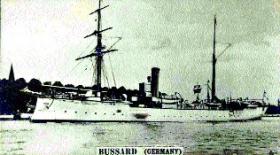
She was followed on 2 May by another German cruiser, Bussard
The next port, Port Nolloth, was reached on 23 November, St Helena Bay (not to be confused with the eponymous island) on the 29th, and on 1 December Pandora made fast to No. 5 buoy in Simon’s Bay, home base of the Cape squadron. Founded by the Dutch in 1714, it became the headquarters of the then British South Atlantic squadron in 1814. The flagship, Hermes, was in port, and the following days were occupied with coaling, cleaning and painting the ship and provisioning.
On 17 December, Pandora ‘landed small arms companies, forced march to the top of Red Hill, owing to the hot weather several of the men had to fall out . . . they were interviewed by the doctor on arrival onboard’. Red Hill was the site of the naval sanatorium, chosen apparently to discourage the patients from ‘escaping’ to visit the local hostelries. A similar rigour prevailed on Pandora. Christmas Day ‘passed off very quiet (also very dry) no drink allowed onboard by Captain’s order’. Some, however, took matters into their own hands. On 27 December ‘three stokers who had been breaking leave seized a boat from the dockyard & attempted to reach the ship in her, they narrowly escaped being drowned (14 days hard)’.
Up and down the east coast of Africa
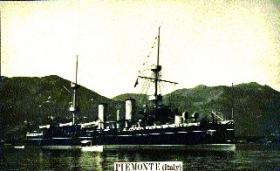
On 20 May 1910 the Italian cruiser Piemonte fired 101 ‘minute guns’ in memory of the late King Edward VII
On 12 April ‘Saluted the Sultan of Zanzibar with 21 guns, recd. 18 bags of long looked for letters. For the next few days the ship was practically besieged by British and foreign ministers, consuls, &c &c & the gunner & his staff were kept pretty busy firing salutes’. There indeed can scarcely have been a moment when the port was not echoing to the sound of gunfire. On 30 April, in Zanzibar, ‘German cruiser Seeadler arrived & saluted the country with 21 guns’; she was followed on 2 May by another German cruiser, Bussard (O’Brien spells it ‘Buzzard’). The following year, on 16 May, Pandora, again in Zanzibar, received courtesy visits from the Italian consul general (salute of eleven guns), the Austrian, French, Portugese, German, Belgian and Norwegian (seven each), while the American vice-consul visited but received no guns. On 20 May Pandora ‘landed an escort & funeral party in the afternoon to take part in King Edward [VII]’s memorial service in the Cathedral. The representatives of all the powers were present. Pandora and Piedmont fired 101 minute guns’. Piedmont was the Italian cruiser Piemonte: Italy had first indicated its imperial intentions in Africa in 1889 by establishing a small protectorate in Somaliland.
Simonstown, East London, Port Elizabeth, Durban, Zanzibar, Mombasa, Pemba—virtually all of Pandora’s many ports of call flew the British flag. The exceptions were Dar-es-Salaam, since 1891 the capital of German East Africa and the base for the German fleet on the African station, and those on the coastline of what was then the Portuguese province (colony after 1910) of Mozambique. Even here, however, there was a significant British presence. On 26 March 1909 Pandora moored in nine fathoms in the harbour of Beira. The following day, ‘Ship’s company were invited to a smoking concert by the British residents of Beira, about 100 men landed for the turn out & had a ripping time. Several fine speeches were made & some good songs were sung and Lager Beer was flowing like water. British Consul presided as Master of Ceremonies, the Portuguese commandant was also present . . .’. The British population then numbered about 300 and, according to O’Brien, ‘they seem to spend most of their time in the hotels drinking whiskey to keep away the fever’. Drinking and driving, however, was evidently not a problem:
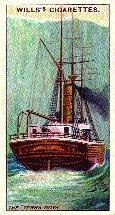
The Terra Nova
There were, however, more serious events to record in the course of Pandora’s routine. On 1 August 1909, when the cruiser was in Durban together with the Forte, ‘S.S. Waratah of the Blue Anchor Line from Durban to Cape Town with about 300 passengers & crew reported missing’. Forte sailed in search of her. After taking on 540 tons of coal, Pandora followed the next day.
‘4th midnight. Spoke S.S. Paprika of N. Zealand Shipping Company, reported no news of missing ship. 5th. Very bad weather. 8th. Shipped several heavy seas which did considerable damage to the deck fittings. 9th. Ship rolling heavily, nearly lost 1st cutter which filled up at davits, took onboard several heavy seas which flooded stoke holds & after compartments & filled up all the cabins aft. Ship behaved as well as could be expected but on more than one occasion it seemed that nothing could prevent her from foundering.’
Pandora returned to Durban short of coal and with no news of the missing vessel. On 10 August she put to sea again for a second search, in the course of which the ship’s dog, Dora, ‘gave birth to 10 pups, 5 sons & 5 daughters’, but no trace of Waratah was found.
The following month the S.S. Umhali of the Ballard King line was wrecked near Oliphant’s Bosch Point on the west coast of the Cape peninsula with the loss of one life. Hermes and Forte ‘put to sea to render assistance. Captain Davidson [of Pandora] & 4 hands visited wreck & rescued a good deal of the passengers’ luggage also a valuable Persian Kitten. The latter was afterwards returned to its owner.’ Also involved in the rescue was the Union Castle liner Galeka, built by Harland & Wolff of Belfast in 1899.
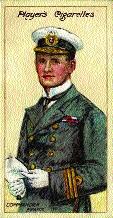
The Terra Nova’s captain, Commander Evans, part of Scott’s British Antarctic Expedition. O’Brien volunteered and was accepted by Evans for service in the expedition but was later turned down by Scott because he was ‘too old at 33’.
Shackleton’s Terra Nova
The year 1910 saw Pandora again heading north for Mombasa and Zanzibar. By the end of June she was back again in Simonstown, engaged in routine duties, fitting a new wireless mast to replace the original that had been carried away in a gale, and welcoming the captain’s wife, who had arrived by Union Castle liner from England. The dog Dora ‘broke her leg & had to undergo an operation to have it set’. Then, on 15 August at 6.20pm, ‘Terra Nova (British Antarctic Expedition) arrived from England bound south’. O’Brien’s log continues:
‘16th. Terra Nova signalled 1 PO short of complement & asked for volunteers from POs of Mutine & Pandora. Volunteered for expedition, visited Terra Nova & found several old friends and shipmates onboard including Lieut. Evans who was in command.
17th. Passed medical exam. Interviewed Captain Evans onboard Terra Nova & was promised the job & £40 per annum in addition to Service pay also bonus at termination of Expedition.
21st. Telegram from C in C [Vice-Admiral G. le C. Egerton] arrived approving [sic] of PO from Pandora discharged to Terra Nova.
23rd. Interviewed Captain Scott leader of the expedition and lost my situation. Too old at 33 Hard Lines. Hands employed during the week refitting Terra Nova, also pumping her out as she was leaking badly. [Pandora had sent a working party to the ship on the 16th, followed by diving parties on the 19th and the 24th.]
25th. POs of Mutine & Pandora & Shore Ratings entertained crew of Terra Nova to smoking concert in R.N.N.Rs, Capt. Scott & his officers also attended & the turn out proved a great success.’
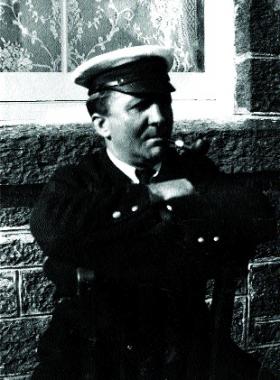
O’Brien in later life.
In Simonstown on 27 August 1910 Pandora ‘slipped buoy and left for E. London. Cheers were exchanged between Terra Nova & Pandora, Terra Nova crew sang Old Lang Syne as the ships were passing each other’. On 1 September Pandora’s paying-off orders arrived. She sailed for Beira on the 8th, where ‘ship’s company were invited to a smoker on shore & had a good evening’s enjoyment. Colonel O’Sullivan [O’Brien’s emphasis] took the chair’. The ship returned to Simons-town, and on 5 October ‘C in C came on board to say goodbye. Left for St Helena at 11.45. Fleet manned ship and cheered.’ At St Helena on the 13th ‘H.M.S. Aeolus arrived with reliefs on board’. At this point O’Brien’s log ends abruptly. Pandora returned to the Cape station with her new crew, but his chance of fame—or death—with Scott’s ill-fated expedition had vanished as soon as it had appeared. Too old at 33? It is more likely that, Tom Crean excepted, Robert Falcon Scott did not have too much time for Irishmen.
William O’Brien subsequently saw service at the World War I Battle of Jutland on the battleship Collingwood, on which, according to family tradition, the midshipmen under his charge included two future kings of England, Edward VIII and George VI. Unable to forsake the sea, on retiring from the navy he became a customs officer in Burghead in the north of Scotland.
Bernard Share is a writer and editor.
















